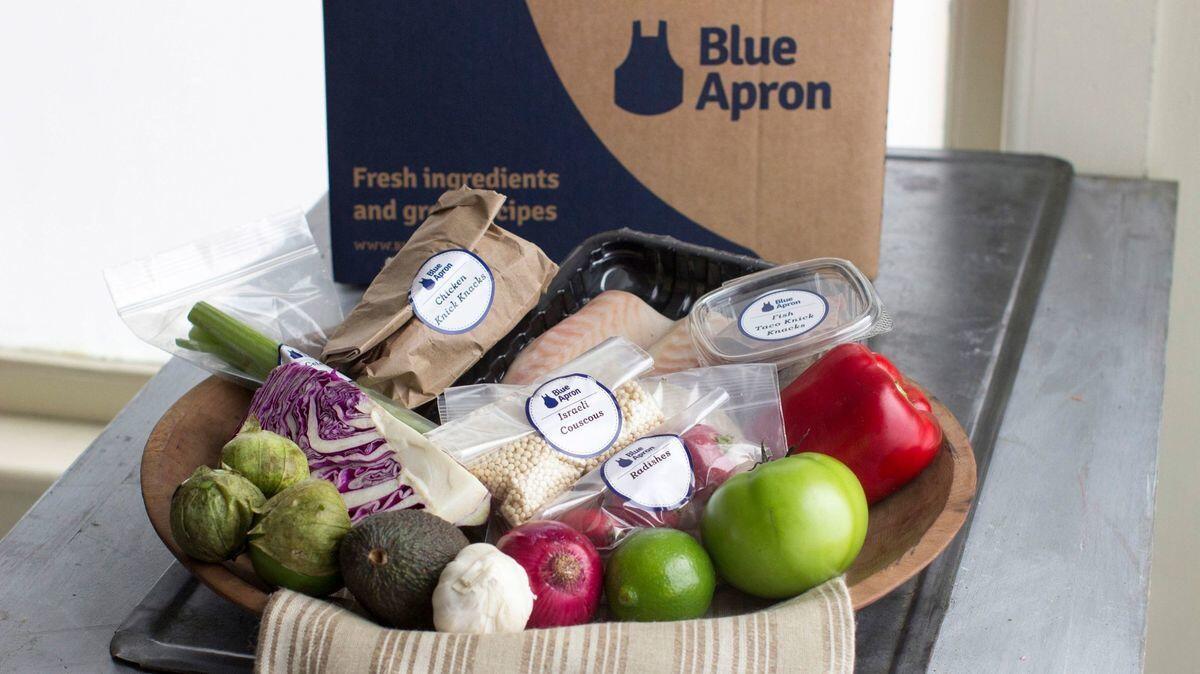Here’s one way Blue Apron is looking to turn itself around in 2019

- Share via
Blue Apron has a New Year’s resolution: sell healthier meals and get more customers.
This week, Blue Apron launched home-delivered meal kits with WW — formerly known as Weight Watchers — that meet WW’s wellness and nutrition standards. The Blue Apron-WW program offers a weekly rotation of recipes, from sweet potato chili to baked chicken with kale, potatoes and caper mayo.
The pairing comes as Blue Apron struggles to hold onto its customers and its stock has sagged below $1. The company has never turned an annual profit. In the last quarter, the company’s net revenue decreased 28% year-over-year to $150.6 million, due largely to lost customers.
Add WW’s widespread membership to Blue Apron’s food services, and Blue Apron Chief Executive Brad Dickerson said he sees a plan to turn the tables in 2019. Blue Apron’s most recently reported customer count stood at 646,000. In the last quarter, WW had 2.8 million members in North America.
“Historically, we’ve been going out and acquiring one customer at a time,” Dickerson said. “This is a great way for us to get our brand in front of multiple customers at a time.”
At its start 6 ½ years ago, Blue Apron was a pioneer for fresh, prepared-meal kits delivered to your door. But meal-kit momentum has slumped in the last few years, and a slew of start-ups were either sold or quickly put out of business. In the meantime, large grocers like Kroger and Albertsons are shaping their own meal-kit programs.
In July 2017, the company’s stock debuted at $10 a share but was plagued with bad timing from the start. Blue Apron went public just after Amazon.com announced plans to buy Whole Foods, a deal that sounded alarms that the online retailer might move into the meal-delivery space. On Thursday, the share price closed at 92 cents.
In November, Blue Apron laid out a plan for profitability in 2019. It focused on the company’s direct-to-consumer business, especially for customers who already showed a strong affinity for the brand. (The top 30% of Blue Apron’s customers generate more than 80% of the company’s net revenue, the company said.)
In October, Blue Apron began working with Jet.com, selling same-day or next-day delivery through Jet’s grocery services for customers in and around New York City. And Blue Apron is looking to lock in customers who may not sign on for weekly meals, but who may want to buy meals on-demand or from bricks-and-mortar retailers like Costco.
Dickerson said Blue Apron would pay WW a small acquisition fee for every member who becomes a new Blue Apron subscriber. Neither Dickerson nor WW would go into specific deals about the financial arrangement. The WW menu costs the same as Blue Apron’s existing two-serving meal plan at $59.94 per week, or $9.99 per serving.
By joining forces with Blue Apron, WW is also looking to build on a campaign of new messaging. In September, the company dropped its famous brand name in exchange for something slimmer. A new logo — two Ws in place of the “Weight Watchers” nameplate — was meant to shift company and customer focus toward overall health and well-being. In turn, the company is aiming to put less of an emphasis on tallying calories and losing weight.
The Blue Apron menu is a part of the WW Freestyle program, which features an expanded list of foods dubbed “ZeroPoint,” going beyond fruits and vegetables to include more than 200 options.
Linda Bolton Weiser, a senior research analyst at the financial services company D.A. Davidson, said Blue Apron is likely to benefit more than WW from the partnership, given WW’s broad customer base. WW had previously piloted meal delivery subscription services, but is now focusing on Blue Apron, the company said.
“[WW] just wants to give more and more to their members in terms of being able to stay on the plan, live the life they want anywhere, anyplace,” Weiser said. “Blue Apron fits into that.”
But there may be only so much room to grow. Packaged Facts, a consulting firm, reported in November that the U.S. meal-kit market had sales of $2.6 billion last year. The firm predicted that the market will grow almost 22% by the end of 2018, to $3.1 billion. But that growth, Packaged Facts said, is forecast to steadily decline over the next few years, going from double to single-digit gains by 2023.
Dickerson disagrees.
“We don’t think there’s going to be any shortage of customer needs for meal solutions,” he said. “There’s much more competition out there to serve those needs.”
More to Read
Inside the business of entertainment
The Wide Shot brings you news, analysis and insights on everything from streaming wars to production — and what it all means for the future.
You may occasionally receive promotional content from the Los Angeles Times.










